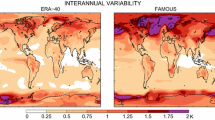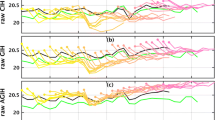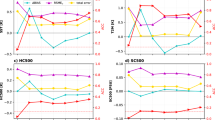Abstract
A method is proposed to initialise coupled atmosphere-ocean general circulation models (AOGCMs) developed to study climate change on multi-century time scales. The method assumes that current generation AOGCMs are developed and evaluated using present-day radiative forcing and near present day oceanic initial conditions. To find pre-twentieth century initial conditions, we propose that the radiative forcing be run backwards in time from the present to the desired starting date. The model should then be run for 3–5 centuries with the radiative forcing held constant at the desired date. In our tests, instantaneously switching to pre-twentieth century radiative forcing did not save computational time. When a sufficiently stable pre-twentieth century condition is achieved, the coupled system can be integrated forward to the present and into the future. This method is a first step toward the standardization of AOGCM initialization and suggests a framework for AOGCM initialization for the first time. It provides an internally consistent set of pre-twentieth century initial conditions, although they will vary from model to model. Furthermore, it is likely that this method will yield a fairly realistic present-day climate in transient climate change experiments of the twentieth century, if the model biases are not too large. The main disadvantage of the method is that it is fairly computationally expensive in that it requires an additional 4–6 centuries of model integration before starting historical twentieth century integrations. However, the relative cost of this technique diminishes as more simulations are conducted using the oceanic initial condition obtained using our method.







Similar content being viewed by others
References
Bitz CM, Holland MM, Weaver AJ Eby M (2001) Simulating the ice-thickness distribution in a coupled climate model. J Geophys Res 106: 2441–2463
Dixon KW, Lanzante JR (1999) Global mean surface air temperature and North Atlantic overturning in a suite of coupled GCM climate change experiments. Geophys Res Lett 26: 1881–1888
Duffy PB, Eby M, Weaver AJ (1999) Effects of sinking of salt rejected during formation of sea ice on results of a global ocean-atmosphere-sea ice climate model. Geophys Res Lett 26: 1739–1742
Duffy PB, Eby M, Weaver AJ (2001) Climate model simulations of effects of increased atmospheric CO2 and loss of sea ice on ocean salinity and tracer uptake. J Clim 14: 520–532
Ewen TL, Weaver AJ, Eby M (2004) Sensitivity of the inorganic ocean carbon cycle to future climate warming in the UVic coupled model. Atmosphere-Ocean, (in press)
Fanning AF, Weaver AJ (1996) An atmospheric energy moisture-balance model: climatology, interpentadal climate change and coupling to an OGCM. J Geophys Res 101: 15,111–15,128
Griffies SM, Harrison MJ, Pacanowski RC, Rosati A (2003) A technical guide to MOM4. GFDL Ocean Group Techn Rep 5, available online at www.gfdl.noaa.gov
Hasselmann K, Sausen R, Maier-Reimer E,Voss R (1993) On the cold start problem in transient simulations with coupled ocean-atmosphere models. lim Dyn 9: 51–61
Hewitt CD, Stouffer RJ, Broccoli AJ, Mitchell JFB, Valdes PJ (2003) The effect of ocean dynamics in a coupled GCM simulation of the Last Glacial Maximum. Clim Dyn 20: 203–218
Holland MM, Bitz CM, Eby M, Weaver AJ (2001) The role of ice ocean interactions in the variability of the North Atlantic thermohaline circulation. J Clim 14: 656–675
Hunke EC, Dukowicz JK (1997) An elastic-viscous-plastic model for sea ice dynamics. J Phys Oceanogr 27: 1849–1867
Levitus S (1982) Climatological atlas of the world ocean NOAA/ERL GFDL Prof Pap 13, Princeton, N.J. USA pp 173 (NTIS PB83-184093)
Levitus S, Burgett R, Boyer TP (1994a) World Ocean atlas 1994, volume 3: salinity. NOAA Atlas NESDIS 3, US Government Printing Office, Washington, D.C. USA pp 111
Levitus S, Boyer TP, Antonov J (1994b) World Ocean Atlas 1994, volume 4: temperature. NOAA Atlas NESDIS 4, US Government Printing Office, Washington, D.C. USA pp 129
Levitus S, Conkright ME, Antonov JI, Baranova O, Boyer TP, Garcia HE, Gelfeld R, Johnson D, Locarnini RA, Murphy PP, O’Brien TD, Smolyar I, Stephens C (2002) World Ocean Database 2001, volume 1: introduction. NOAA Atlas NESDIS 42, U.S. Government Printing Office, Washington, D.C. USA pp 167
Manabe S, Stouffer RJ, Spelman MJ, Bryan K (1991) Transient responses of a coupled ocean-atmosphere model to gradual changes of atmospheric CO2. Part I: Annual mean response. J Clim 4: 785–818
Matthews HD, Weaver AJ, Eby M, Meissner KJ (2003) Radiative forcing of climate by historical land cover change. Geophys Res Lett 30(2): 27:1–27:4, 1055, doi:10.1029/2002GL016098
Matthews HD, Weaver AJ, Meissner KJ, Gillett NP, Eby M (2004) Natural and anthropogenic climate change: Incorporating historical land cover change, vegetation dynamics and the global carbon cycle. Clim Dyn (in press)
Meissner KJ, Schmittner A, Weaver AJ, Adkins JF (2003a) The ventilation of the North Atlantic Ocean during the Last Glacial Maximum — a comparison between simulated and observed radiocarbon ages. Paleoceanography, 18: 1023 doi:10.1029/2002PA000762
Meissner KJ, Weaver AJ, Matthews HD, Cox PM (2003b) The role of land-surface dynamics in glacial inception: a study with the UVic Earth System Model. Clim Dyn 21: 511–537
Mitchell JFB, Johns TC, Gregory JM, Tett SFB (1995) Climate response to increasing levels of greenhouse gases and sulphate aerosols. Nature 376: 501–504
Moore III, B, Gates WL, Mata LJ, Underal A (2001) Advancing our understanding. In: Climate change 2001: the scientific basis. Contribution of Working Group I to the Third Assessment Report of the Intergovernmental Panel on Climate Change, Cambridge University Press Cambridge, UK pp 526–582
Ramaswamy V, Boucher O, Haigh J, Hauglustaine D, Haywood J, Myhre G, Nakajima T, Shi GY, Solomon S (2001) IPCC Chapter 5, Advancing our understanding. In: Climate change 2001: the scientific basis. Contribution of Working Group I to the Third Assessment Report of the Intergovernmental Panel on Climate Change, Cambridge University Press, Cambridge, UK pp 341–416
Schmittner A, Meissner KJ, Eby M, Weaver AJ (2002) Forcing of the deep ocean circulation in simulations of the Last Glacial Maximum. Paleoceanography 17(2): 5:1–5:15, 1015, doi:10.1029/2001PA000633
Stott PA, Tett SFB, Jones GS, Allen MR, Mitchell JFB, Jenkins GJ (2000) External control of twentieth century temperature by natural and anthropogenic forcings. Sci 290: 2131–2137
Stouffer RJ (2004) Time scales of climate response. J Clim 17: 201–217
Stouffer RJ, Dixon KW (1998) Initialization of coupled models for use in climate studies: a review. In: research activities in atmospheric and oceanic modelling, Rep 27, WMO/TD-No. 865, World Meteorological Organization, Geneva, Switzerland, pp I.1-I.8
Weaver AJ, Hughes TMC (1996) On the incompatibility of ocean and atmosphere models and the need for flux adjustments. Clim Dyn 13: 141–170
Weaver AJ, Eby M, Fanning AF, Wiebe EC (1998) Simulated influence of carbon dioxide, orbital forcing and ice sheets on the climate of the last glacial maximum. Nature 394: 847–853
Weaver AJ, Duffy PB, Eby M, Wiebe EC (2000) Evaluation of ocean and climate models using present-day observations and forcing. Atmosphere-Ocean 38: 271–301
Weaver AJ, Eby M, Wiebe EC, Bitz CM, Duffy PB, Ewen TL, Fanning AF, Holland MM, MacFadyen A, Matthews HD, Meissner KJ, Saenko O, Schmittner A, Wang H, Yoshimori M (2001) The UVic Earth System Climate Model: model description, climatology and application to past, present and future climates. Atmosphere-Ocean 39: 361–428
Acknowledgements
We are indebted to our colleagues in the WCRP WGCM, and especially Larry Gates, and John Mitchell, for many stimulating discussions over many WCRP WGCM meetings, which ultimately lead to the writing of this manuscript. We are also indebted to K. Dixon, T. Delworth, J Meehl and J Gregory for their many thoughtful comments on this work. AJW is also grateful for funding support from the NSERC/CFCAS CLIVAR Program and for release time and funding provided by the Killam Foundation and the Canada Research Chair programs.
Author information
Authors and Affiliations
Corresponding author
Rights and permissions
About this article
Cite this article
Stouffer, R.J., Weaver, A.J. & Eby, M. A method for obtaining pre-twentieth century initial conditions for use in climate change studies. Climate Dynamics 23, 327–339 (2004). https://doi.org/10.1007/s00382-004-0446-5
Received:
Accepted:
Published:
Issue Date:
DOI: https://doi.org/10.1007/s00382-004-0446-5




